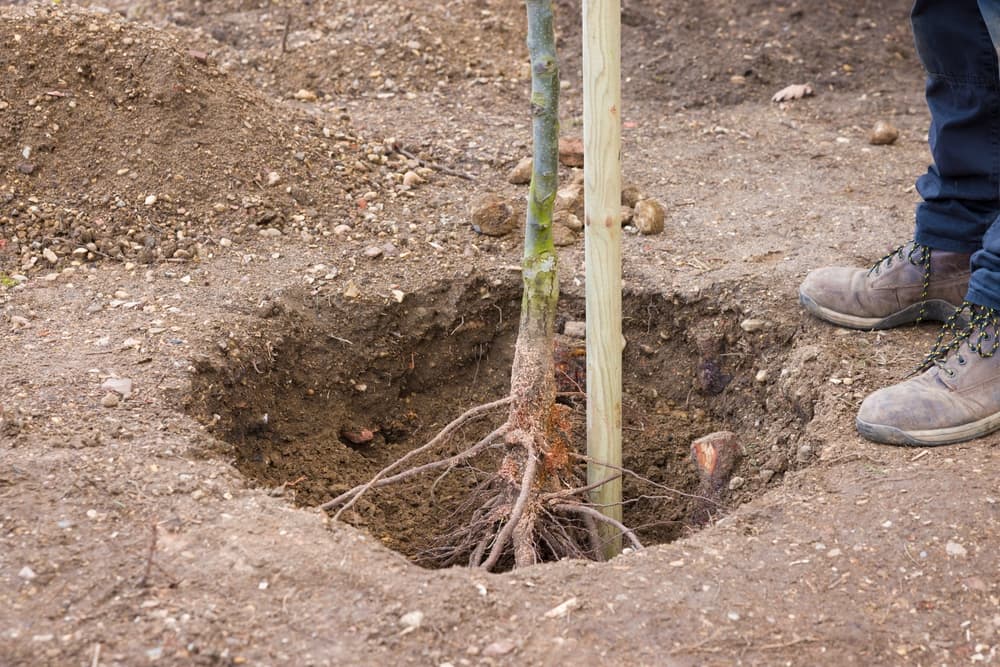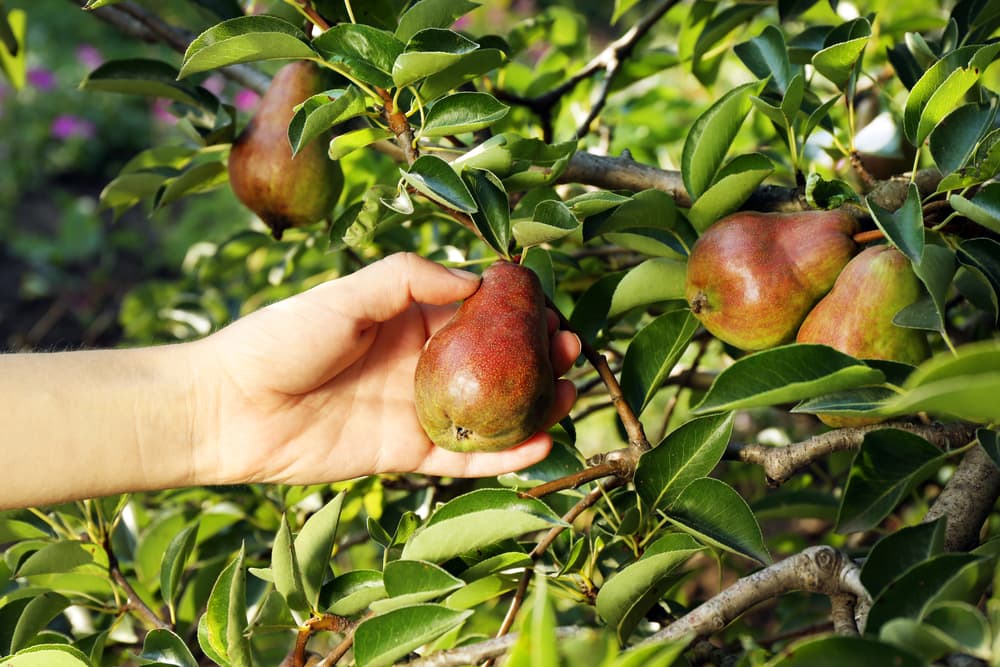How To Add A Pear Tree (Or Two!) To Your Garden For Early, Mid Or Late-Season Fruit

FRUIT > PEAR

Elizabeth is a Permaculture Garden Designer, Sustainability Consultant and Professional Writer, working as an advocate for positive change. She graduated from the University of St. Andrews with an MA in English and Philosophy and obtained a Diploma in Applied Permaculture Design from the Permaculture Association.
Reviewed By DAN ORI

Dan has over 27 years’ under his belt caring for plants and gardens. Working as a Horticultural Instructor and Consultant, he draws on a diverse range of experience that includes working as a Head Gardener, Tree Surgeon, Garden Centre Trouble Shooter, and writer of academic papers. Dan has a Level 3 Diploma in Horticulture and is currently a candidate for the RHS’s most prestigious award – The Master of Horticulture.
IN THIS GUIDE
PEAR GUIDES
Adding a pear tree or two to your garden could be an excellent choice.
If you love to eat pears, you might be able to grow your very own supply of these fruits in your garden.
Pear trees are native to mild areas across Europe.1Pear (Pyrus communis). (n.d.). Woodland Trust. Retrieved March 22, 2023, from https://www.woodlandtrust.org.uk/trees-woods-and-wildlife/british-trees/a-z-of-british-trees/pear/
These trees sit in the Pyrus genus, which is in the Rosaceae plant family along with roses, and many species of edible fruit such apricot, nectarine and more.2Petruzzello, M. (2014, November 19). List of plants in the family Rosaceae. Encyclopedia Britannica. Retrieved March 22, 2023, from https://www.britannica.com/topic/list-of-plants-in-the-family-Rosaceae-2001612
Around 3,000 varieties of pear are grown and eaten around the world.3Pears. (2021, September 27). FoodPrint. Retrieved March 22, 2023, from https://foodprint.org/real-food/pears/
Overview
| Botanical Name | Pyrus communes |
| Common Name(s) | Pear |
| Plant Type | Fruit Tree |
| Native Area | Temperate Europe |
| Hardiness Rating | H6 |
| Foliage | Deciduous |
| Flowers | White blossom |
| When To Plant | April, May, September, October |
| Harvesting Months | September, October, November |
Sunlight
Preferred
Full Sun
Exposure
Sheltered
Size
Height
4 – 8M
Spread
4 – 8M
Bloom Time
Spring
Soil
Preferred
Clay, loam, sand
Moisture
Moist but well-drained
pH
Any
The pear is a pome fruit, like the medlar and the quince for example.
The most important species of Pyrus used for orchard and garden cultivars in Europe, North America and Australia is Pyrus communis – the European pear.
Though pear trees are not quite as hardy as apples, they can be grown across much of the UK, and in fact, need some winter chilling to produce fruit.
Pear Tree Varieties

Of the various cultivars of pear trees grown in the UK, some of the options to consider are:
- ‘Beth’
- ‘Beurre Hardy’
- ‘Concord’
- ‘Conference’
- ‘Doyenne du Comice’
- ‘Flower of Monorgan’
- ‘Grey Auchan’
- ‘Invincible’
- ‘Jargonelle’
- ‘Longueville’
- ‘Louise Bonne of Jersey’
- ‘Maggie’
- ‘Merton Pride’
- ‘Onward’
- ‘Seckle’
- ‘Seggie Den’
- ‘Pitmaston Duchesse’
- ‘Williams Bonne Chrétienne’
- ‘Winter Nellis’
When choosing a pear tree it should be noted that some of the above will be suitable for northern England and Scotland, while other varietals will really only thrive in the south.
It is a good idea to consider heritage varieties from your particular area.
When choosing a pear, you might also like to think about how the different varietals compare when it comes to taste, and whether you are looking for eating or cooking pears.

You should also consider whether you would like an early, mid-season or late-season pear.
Pollination
Remember, too, that yields will usually be better if you plant two cultivars from the same flowering period (pollination group) or ones that have an overlapping flowering period.
Some pears are also poor pollinators and so two additional trees will usually be required to pollinate this tree, and each other.
“You will normally find when buying a pear tree from a UK garden centre or nursery that it is on one of two rootstock types, Quince A and Quince C,” shares Horticultural Consultant Dan Ori.
“A Quince C rootstock pear can be trained into a dwarf pyramid, bush, cordon, espalier and fan form. Quince C rootstocks can be a good choice when growing in a large container.
“Regardless of form, you will need to keep trees on this rootstock staked or supported permanently.
“A Quince A rootstock pear can be trained into a dwarf pyramid, bush, cordon, double and multiple cordons, pole, espalier, fan and semi-standard form. This rootstock tolerates average soil but thrives better in rich soils.
“Quince A trees may only need to be staked or supported for the first 5 years if you are not growing in a trained form.”
Planting A Pear Tree
One important thing to note when deciding where to place new pear trees is that they flower pretty early, and so their blossom can be damaged by spring frosts.

It is important to choose a location that is not in a frost pocket, and which is as warm and sheltered as possible – especially if you live further north.
It can be a good idea to position a pear tree close to or against a sunny south or west-facing wall.
You should grow a pear tree in fertile, moist but well-drained or well-drained soil or growing medium.
Pear trees can be grown as half-standard trees in gardens where space is not an issue.

Where space is limited, growing pears in bush-trained forms, as fans, espaliers, pyramid or cordon forms can allow pear trees to be grown even in much smaller spaces.
Smaller pear trees can also be grown in containers, providing that these are of sufficient size.
When To Plant
Pear trees can be purchased in pots throughout the year, but are best planted out in spring or autumn, when the ground is not waterlogged nor too dry, and the weather is not too hot.
However, it is cheaper, and often the best idea, to purchase and plant bare-root pear trees during the dormant period, between late autumn and early spring.
Late summer or early autumn is a good time to choose and order pear trees for your garden.
How To Plant
Once your pear tree or trees arrive, plant out as soon as possible.
Make sure you have prepared a suitable site for your new garden additions.
As with other fruit trees, you should dig a planting hole as deep as the rootball and twice as wide.

It is a good idea to incorporate some compost and perhaps some mycorrhizal fungi into the planting hole to aid establishment.
Refill the soil then water in well – add an organic mulch around the base of the tree and stake or add a protective collar if necessary.
Creating A Guild
In an organic garden, it is a good idea to create a guild of beneficial companion plants around your pear tree.

A well-chosen guild will help you keep your pear tree healthy, and boost the yields that you are able to achieve.
The plants in a guild are chosen because they confer certain benefits without creating too much competition for your new tree.
The plants chosen for a guild might:
- Yield environmental benefits – keeping the soil covered to reduce moisture losses, for example.
- Add fertility – nitrogen fixers add nitrogen while in growth or when chopped and dropped around the base of the tree. Deep-rooted plants can often dynamically accumulate other nutrients from the deeper soil which pear trees cannot reach. These can also be chopped and dropped around the tree, or left to die back or drop their leaves each winter to naturally return nutrients to the surface of the soil.
- Attract pollinators and ensure good fruit set.
- Attract other beneficial wildlife like predatory insects – these help keep pest numbers down and the ecosystem in balance.
- Repel, confuse or distract pest species.
For example, around a pear tree you might plant:
- Comfrey – deep-rooted dynamic accumulator, attracts pollinators.
- White clover – nitrogen fixing, ground cover.
- Herbs (e.g. yarrow, borage, tansy, angelica, thyme etc..) for beneficial attraction and pest control.
- Alliums (e.g. chives, perennial edible onions, ornamental alliums) for pest control.
- Early spring flowers and bulbs for nutrient retention and pollination services early in the year.
Of course, there are many other options you could consider.
Pear Tree Care
Watering
Pear trees in the ground will need watering during dry periods until they become established.
After they are established, they will need to be watered only during prolonged periods of drought.
Of course, pear trees grown in containers will require more regular watering.
Feeding
Replenishing your organic mulch around your tree, creating a guild around it, and chopping and dropping plant material from this guild over time should be sufficient to keep your pear tree happy, healthy and productive.

If growing a pear tree in a container, you should scoop out and replace the top third of the potting mix every year to replenish the nutrients it contains.
Common Problems
Pears can be susceptible to a number of pests and diseases.
Some common pests include aphids, caterpillars, codling moths, pear midge, pear blister mite and pear slugworm.
Pear trees can succumb to diseases such as pear scab, pear rust, blossom wilt, brown rot, and fireblight.
Making sure that you choose the right location for your tree, watering and pruning correctly, and ensuring healthy biodiversity in your garden can all help keep issues to a minimum.
But make sure you keep a close eye on your pear tree so you can deal with any problems swiftly if they do occur.
Harvesting Pears
Most pears in the UK will be ready to harvest sometime in September.
Pears are picked just before they have ripened fully – the flesh should feel firm and the fruit should have demonstrated a recent (though slight) change in colour.
Pears that you have harvested should then be stored for a period before eating.

Early varieties will usually be ready to eat within a week or two, but later varieties may need much longer, even months, before they are ready to eat.
The tips above should help you understand the basics – over time, you will learn more about your own particular pear tree or trees and the best strategies to employ.
References
- 1Pear (Pyrus communis). (n.d.). Woodland Trust. Retrieved March 22, 2023, from https://www.woodlandtrust.org.uk/trees-woods-and-wildlife/british-trees/a-z-of-british-trees/pear/
- 2Petruzzello, M. (2014, November 19). List of plants in the family Rosaceae. Encyclopedia Britannica. Retrieved March 22, 2023, from https://www.britannica.com/topic/list-of-plants-in-the-family-Rosaceae-2001612
- 3Pears. (2021, September 27). FoodPrint. Retrieved March 22, 2023, from https://foodprint.org/real-food/pears/
